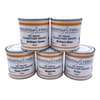Gold Leaf Across the World - Slovenia
- by Sam Wozniak
Gold Leaf in Slovenia: A Golden Thread Through History, Art, and Restoration
Slovenia may be a small country in Central Europe, but it boasts a rich cultural and artistic heritage that stretches back centuries. Among the many traditional materials used in its religious and artistic practices, gold leaf (zlata listič) holds a special place. From the grandeur of Baroque churches to the precision of contemporary restoration (obnova), gold leaf — especially 24 carat (24-karatni) and 23.5 carat (23,5-karatni) — has been used to enhance Slovenia’s sacred spaces, royal artifacts, and even modern art.
In this article, we’ll explore the history, uses, and restoration of gold leaf across Slovenia, delving into its application in gilding, monumental architecture, and evolving contemporary practices.
What Is Gold Leaf?
Gold leaf (zlata listič) is an ultra-thin sheet of gold, usually hand-beaten, used to cover surfaces for decorative or symbolic purposes. It has been prized for millennia due to its durability, malleability, and timeless brilliance. In Slovenia, gold leaf is typically used in gilding (pozlata), the process of applying gold to surfaces such as wood, stone, metal, or glass.
Most historical Slovenian goldwork uses 23.5 carat gold leaf — chosen for its excellent combination of purity and strength. 24 carat gold leaf, while more delicate, is used when the deepest, most luminous finish is desired.
Historical Use of Gold Leaf in Slovenia
Medieval Roots and Religious Influence
Gold leaf (zlata listič) first appeared in Slovenia during the medieval period, particularly in illuminated manuscripts, sacred objects, and church altars. The influence of the Catholic Church played a central role in its development, as gold was seen as a symbol of divine light, purity, and holiness. Many Slovenian monasteries and churches from the 12th to 15th centuries were adorned with gilded (pozlačen) elements.
Church altarpieces, crucifixes, and relics often used gold leaf to draw attention to sacred figures. Even today, remnants of these early gilding techniques can be found in the monumental ecclesiastical structures of towns like Ptuj, Celje, and Škofja Loka.
Baroque Splendour and Monumental Gilding
The 17th and 18th centuries marked the Baroque period, a golden age of monumental gilding in Slovenia. Influenced by Austrian and Italian styles, Slovenian churches saw an explosion of ornate decoration, much of it covered in goldleaf. During this era, gilding techniques became more refined, and the widespread use of 23.5 carat gold leaf ensured a warm, rich sheen that defined Baroque interiors.
One of the most famous examples is the Franciscan Church of the Annunciation (Frančiškanska cerkev Marijinega oznanjenja) in Ljubljana. The high altar and surrounding architecture incorporate detailed gilded wood carvings that reflect the wealth and faith of the time.
Other monumental religious sites that exemplify Baroque gilding include:
-
Stična Abbey (Cistercian Monastery)
-
Church of St. Nicholas in Novo Mesto
-
Brezje Basilica, a key pilgrimage site with an elaborately gilded altar
Traditional Techniques and Craftsmanship
Gilding in Slovenia was traditionally done using two main techniques: water gilding and oil gilding. Water gilding, which involves applying gold leaf over a layer of clay and rabbit-skin glue, was common in indoor religious art and altars. Oil gilding, using an adhesive known as “size”, was reserved for outdoor or larger decorative objects.
Slovenian gilders, often trained through religious institutions or apprenticeships, were known for their precision and commitment to traditional craftsmanship. Gilded picture frames, reliquaries, and liturgical furniture were often completed with 23.5 carat gold leaf, as it was less prone to flaking than pure 24 carat.
Gold Leaf in Slovenian Art and Architecture
Outside of churches, gold leaf has long been a feature of Slovenian art and monumental architecture. Many historic castles, including Ljubljana Castle and Predjama Castle, have rooms or artifacts that display elements of gold gilding — a nod to the prestige of noble families.
During the 19th and early 20th centuries, gold leaf was also used in the Secessionist (Art Nouveau) movement in Slovenia. Artists like Ivan Vurnik and Jože Plečnik incorporated gold leaf details in architectural ornamentation and interior design, especially in places like the Ljubljana Central Market and Žale Cemetery.
Goldleaf added symbolic and aesthetic value, enhancing everything from civic buildings to tombstones.
Gold Leaf in Modern Slovenian Restoration
Today, the application of gold leaf plays a central role in the restoration (obnova) of Slovenia’s cultural heritage. Government-supported initiatives often focus on restoring churches, altars, frames, and historic facades using traditional gilding techniques and authentic materials — most notably 23.5 carat gold leaf.
Restoration teams use detailed historical analysis to determine the original materials and gilding methods. In cases where original 24 carat gold leaf was used, restorers aim to match the purity to ensure both visual authenticity and historical accuracy.
For example, recent restoration efforts at St. James’s Church in Ljubljana and Ptuj Castle have involved extensive goldleaf work to preserve monumental interiors that were at risk of degradation due to moisture or age.
Contemporary Uses: Gold Leaf in Slovenian Design and Art
Slovenian designers and visual artists continue to explore the possibilities of gold leaf in modern applications. In recent years, contemporary painters and sculptors have turned to 24 carat gold leaf to evoke themes of luxury, spirituality, and decay.
Goldleaf has also found its way into Slovenian product design, particularly in luxury packaging, jewellery, and ceramics. Boutique artisan workshops in Ljubljana and Maribor now offer handmade goods that incorporate gilded patterns — blending old-world craftsmanship with modern aesthetics.
Even edible gold leaf has begun to appear in upscale Slovenian cuisine. High-end patisseries and restaurants have started using 24 carat gold to decorate truffles, cakes, and gourmet dishes, offering a touch of elegance rooted in centuries-old tradition.
Why Gold Leaf Still Matters in Slovenia
Gold leaf is more than just decoration — it is a cultural artifact, a symbol of spiritual reverence, and a tool of artistic expression. Whether used in the grand altars of Baroque churches or in the minimalist canvases of modern artists, gilding remains a vital thread in Slovenia’s artistic identity.
The use of 23.5 carat and 24 carat gold leaf reflects both a respect for historical accuracy and an appreciation for aesthetic brilliance. Through ongoing restoration efforts, Slovenia ensures that its monumental works of art and architecture continue to inspire future generations.
Conclusion
Slovenia’s relationship with gold leaf is one of elegance, history, and enduring artistry. From the medieval monasteries of Škofja Loka to the Baroque grandeur of Ljubljana and the evolving spaces of modern design, gilding has helped shape the country’s visual and spiritual culture. Whether through monumental architecture, delicate restorations, or cutting-edge art, goldleaf continues to shine — literally and symbolically — across Slovenia.






